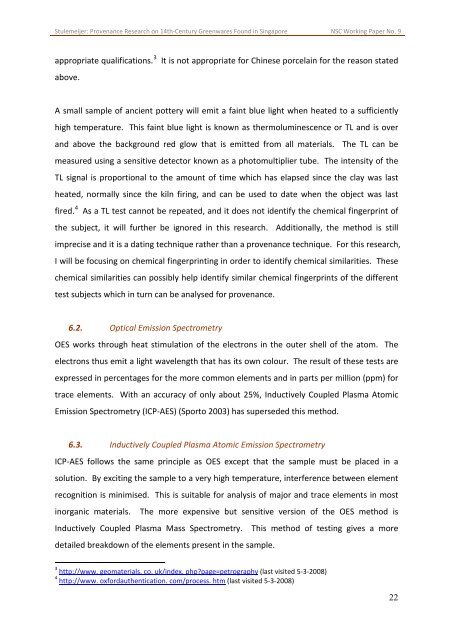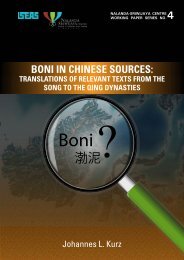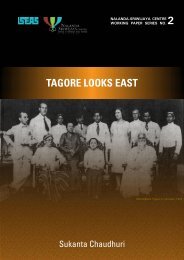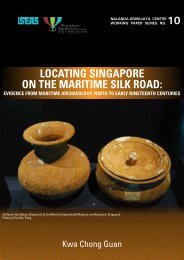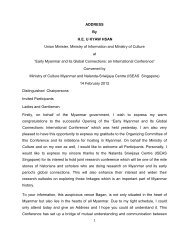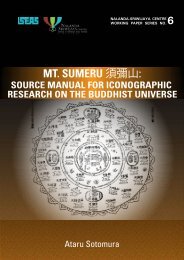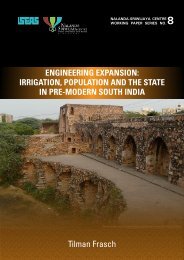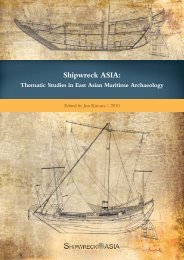provenance research on 14th-century greenwares found in singapore
provenance research on 14th-century greenwares found in singapore
provenance research on 14th-century greenwares found in singapore
You also want an ePaper? Increase the reach of your titles
YUMPU automatically turns print PDFs into web optimized ePapers that Google loves.
Stulemeijer: Provenance Research <strong>on</strong> <strong>14th</strong>-Century Greenwares Found <strong>in</strong> S<strong>in</strong>gapore NSC Work<strong>in</strong>g Paper No. 9<br />
appropriate qualificati<strong>on</strong>s. 3<br />
above.<br />
It is not appropriate for Ch<strong>in</strong>ese porcela<strong>in</strong> for the reas<strong>on</strong> stated<br />
A small sample of ancient pottery will emit a fa<strong>in</strong>t blue light when heated to a sufficiently<br />
high temperature. This fa<strong>in</strong>t blue light is known as thermolum<strong>in</strong>escence or TL and is over<br />
and above the background red glow that is emitted from all materials. The TL can be<br />
measured us<strong>in</strong>g a sensitive detector known as a photomultiplier tube. The <strong>in</strong>tensity of the<br />
TL signal is proporti<strong>on</strong>al to the amount of time which has elapsed s<strong>in</strong>ce the clay was last<br />
heated, normally s<strong>in</strong>ce the kiln fir<strong>in</strong>g, and can be used to date when the object was last<br />
fired.<br />
4<br />
As a TL test cannot be repeated, and it does not identify the chemical f<strong>in</strong>gerpr<strong>in</strong>t of<br />
the subject, it will further be ignored <strong>in</strong> this <str<strong>on</strong>g>research</str<strong>on</strong>g>. Additi<strong>on</strong>ally, the method is still<br />
imprecise and it is a dat<strong>in</strong>g technique rather than a <str<strong>on</strong>g>provenance</str<strong>on</strong>g> technique. For this <str<strong>on</strong>g>research</str<strong>on</strong>g>,<br />
I will be focus<strong>in</strong>g <strong>on</strong> chemical f<strong>in</strong>gerpr<strong>in</strong>t<strong>in</strong>g <strong>in</strong> order to identify chemical similarities. These<br />
chemical similarities can possibly help identify similar chemical f<strong>in</strong>gerpr<strong>in</strong>ts of the different<br />
test subjects which <strong>in</strong> turn can be analysed for <str<strong>on</strong>g>provenance</str<strong>on</strong>g>.<br />
6.2. Optical Emissi<strong>on</strong> Spectrometry<br />
OES works through heat stimulati<strong>on</strong> of the electr<strong>on</strong>s <strong>in</strong> the outer shell of the atom. The<br />
electr<strong>on</strong>s thus emit a light wavelength that has its own colour. The result of these tests are<br />
expressed <strong>in</strong> percentages for the more comm<strong>on</strong> elements and <strong>in</strong> parts per milli<strong>on</strong> (ppm) for<br />
trace elements. With an accuracy of <strong>on</strong>ly about 25%, Inductively Coupled Plasma Atomic<br />
Emissi<strong>on</strong> Spectrometry (ICP-AES) (Sporto 2003) has superseded this method.<br />
6.3. Inductively Coupled Plasma Atomic Emissi<strong>on</strong> Spectrometry<br />
ICP-AES follows the same pr<strong>in</strong>ciple as OES except that the sample must be placed <strong>in</strong> a<br />
soluti<strong>on</strong>. By excit<strong>in</strong>g the sample to a very high temperature, <strong>in</strong>terference between element<br />
recogniti<strong>on</strong> is m<strong>in</strong>imised. This is suitable for analysis of major and trace elements <strong>in</strong> most<br />
<strong>in</strong>organic materials. The more expensive but sensitive versi<strong>on</strong> of the OES method is<br />
Inductively Coupled Plasma Mass Spectrometry. This method of test<strong>in</strong>g gives a more<br />
detailed breakdown of the elements present <strong>in</strong> the sample.<br />
3 http://www. geomaterials. co. uk/<strong>in</strong>dex. phppage=petrography (last visited 5-3-2008)<br />
4 http://www. oxfordauthenticati<strong>on</strong>. com/process. htm (last visited 5-3-2008)<br />
22


